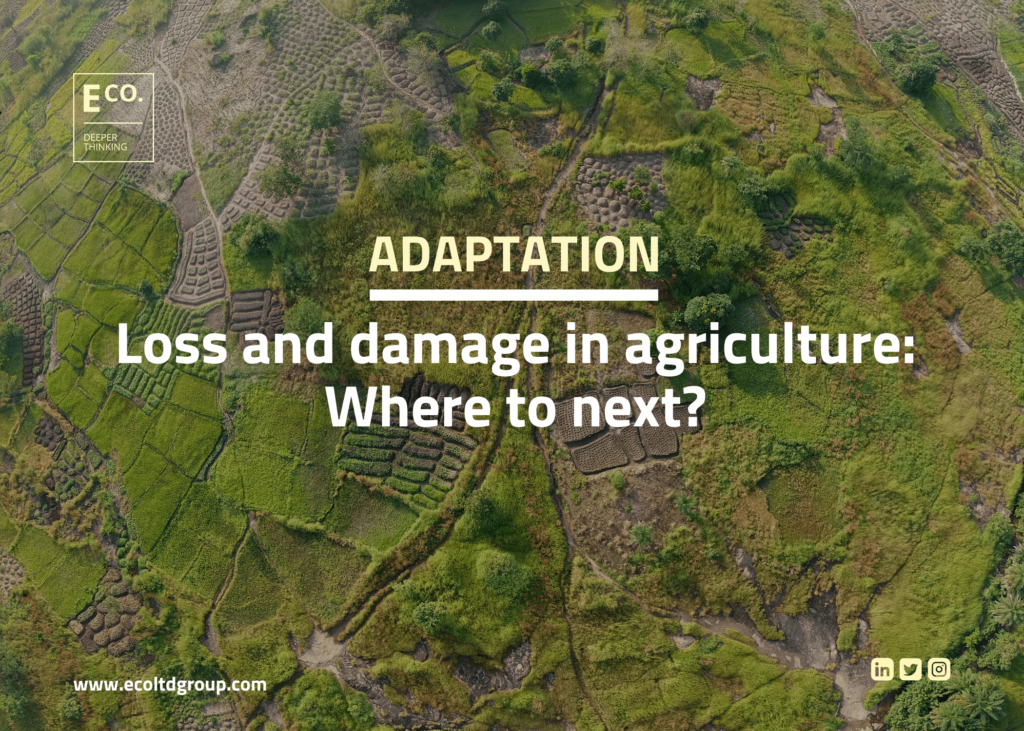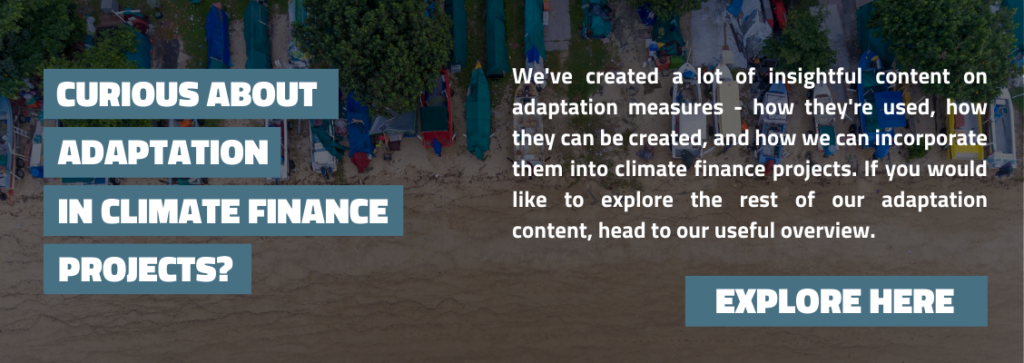Loss and damage in agriculture: Where to next?
4 May 2023, Category: All insights, News, Tags: adaptation, agriculture, climate change, climate finance, loss and damage, project design

By Dr Irina Hauler
Today we’re looking at how Loss & Damage and agriculture intersect. Climate change is already having substantial negative effects on ecosystems, infrastructure, and people’s health and livelihoods around the world. Given its crucial reliance on weather, climate and natural resources for production, the agriculture sector is particularly vulnerable to natural hazards, disasters, and extreme events.
At the same time, agriculture tends to be one of the main economic activities in developing countries, contributing on average between 10 and 20 percent of national Gross Domestic Product (GDP) in lower-middle-income countries and over 30 percent in low-income countries.
What this means for future Loss and Damage developments is important. Any type of L&D Fund, such as the one announced at COP27, needs to account for the impacts on agriculture around the world.
To explore this, this article will look at:
- The background of Loss and Damage in relation to agriculture;
- The limits that Loss and Damage;
- Considering Loss and Damage within project design;
- Where is Loss and Damage going?
The background
The impacts of natural disasters on agriculture lead to significant costs from Loss & Damage (L&D). For example, from 2008–2018, billions of dollars were lost as a result of declines in crop and livestock production in the aftermath of disasters globally. From this, USD 30 billion was lost in sub-Saharan and North Africa, USD 29 billion was lost in Latin America and the Caribbean, USD 8.7 billion was lost across the Small Island Developing States (SIDS) in the Caribbean and USD 49 billion was lost in Asia.[1] The economies of the V20 – a coalition of the world’s most climate-vulnerable countries – have lost an estimated USD 525 billion in the last 20 years due to the impacts of climate change.
In many African countries, the agriculture sector is the backbone of the economy, contributing up to 39 percent (the Niger) or 41 percent (Ethiopia, Mali) to national GDP.[2] Recurrent and prolonged natural hazards and disasters, such as drought, floods, storms, the spread of pests and diseases and saltwater intrusion, can have a devastating impact not only on agricultural livelihoods, but can lead an entire economy into recession. Disasters take lives but also devastate rural livelihoods, destroy food, and contribute to increased hunger.
The costs for loss and damage are primarily being met by the communities and countries most impacted by climate change. Rural families in Bangladesh, for example, spend much of their income protecting themselves from climate impacts like flooding and storms. Indeed, women-led households use up to 30 percent of their total spending to do so.[3]
These costs make it harder for these countries to recover or prepare for future events.

Limits to adaptation
Whilst L&D can be “averted” and “minimised” by curbing greenhouse gas emissions (mitigation) and taking preemptive action to protect communities from the consequences of climate change (adaptation), limits to this occur when efforts to reduce emissions are not ambitious enough and when adaptation efforts are unsuccessful or impossible to implement. A key point in understanding losses and damages is that they can occur despite adaptation and even before limits to adaptation have been reached.
Limits to adaptation are the point at which adaptive responses cease to protect against climate impacts. So, when an adaptation limit is reached, losses and damages will escalate as adaptation is no longer able to reduce negative impacts. However, even before reaching adaptation limits, losses and damages can and do occur. The second instalment of the IPCC’s 6th Assessment Report[6] acknowledges that as the magnitude of climate change increases, so does the likelihood of exceeding adaptation limits.
Adaptation limits can be differentiated into hard and soft limits:
- Soft limits are those for which no further adaptation options are currently feasible but some options might become available in the future. For example, a farmer may not currently be able to afford the cost of irrigation or drought-resistant crops, but these adaptation options may become available to her in the future if she can increase her financial resources.
- Hard limits are those for which existing adaptation options will cease to be effective and additional options are not possible. For example, restoration of coral reefs as an ecosystem-based adaptation option faces hard limits beginning at 1.5°C, as this is when ocean acidification and warming greatly reduce the survivability of coral reefs.
How can you consider Loss & Damage within your project design?
With L&D high on the climate change agenda, it is important to be able to incorporate L&D assessment methodology in many project designs. One of the key aspects of reducing economic loss from disasters consists of a comprehensive analysis of the impacts generated and their associated cost. Detailed assessments of overall loss and damage are regularly carried out by governments and multilateral organisations following large-scale disasters using different methodologies.
However, when applied to agriculture, these assessments often fail to capture the specificities of the sector and result in an imprecise or under-estimated evaluation of disaster impact. This hampers adequate agricultural disaster risk reduction (DRR) policy and planning and leads to under-investment in resilient agriculture.
The Food and Agriculture Organization of the United Nations (FAO) has developed an agriculture-specific methodology, which provides a framework for identifying, analysing and evaluating the impact (damage and loss) of disasters on the sector. [7] This methodology is geared towards measuring the effects of a broad range of disasters of different type, duration or severity and can be applied in different country/regional contexts, and considered for all agricultural subsectors (crops, livestock, apiculture, forestry, aquaculture and fisheries) and their specificities.
Where to next?
Losses and damages will continue to affect agriculture, harming vulnerable communities the most. With the ground-breaking outcome of COP27, the international community will have to work especially diligently on deciding the concrete details of loss and damage funding arrangements, including the newly established fund.
What is equally important, however, is how L&D specificities will be incorporated in the design of projects focused on agricultural adaptation and what could be done to address increasing the soft limits to adaptation in agriculture in order to reduce the impact of losses and damages.

Looking for insight into climate finance? Look no further
Get in touch with our climate finance consultants to discuss a project you’re working on and create successful, fit-for-purpose projects, now and in the future. Email us at: amy@ecoltdgroup.com or find us at the following:
Twitter: @ecoltdnews
LinkedIn: E Co.
Instagram: @ecoltdnews
References
[1] https://www.fao.org/resources/digital-reports/disasters-in-agriculture/en/
[2] World Bank data, 2022
[3] Chatham House, 2022
[4] IPCC, 2022: Climate Change 2022: Impacts, Adaptation and Vulnerability. Contribution of Working Group II to the Sixth Assessment Report of the
Intergovernmental Panel on Climate Change [H.-O. Pörtner, D.C. Roberts, M. Tignor, E.S. Poloczanska, K. Mintenbeck, A. Alegría, M. Craig, S. Langsdorf,
- Löschke, V. Möller, A. Okem, B. Rama (eds.)]. Cambridge University Press. Cambridge University Press, Cambridge, UK and New York, NY, USA,
3056 pp., doi:10.1017/9781009325844.
[5] Ibid
[6] Ibid
[7] Conforti, P., Markova, G., & Tochkov, D. 2020. FAO’s methodology for damage and loss
assessment in agriculture. FAO Statistics Working Paper 19-17. Rome.
https://doi.org/10.4060/ca6990en
Join the conversation by posting a comment below. You can either use your social account, by clicking on the corresponding icons or simply fill in the form below. All comments are moderated.